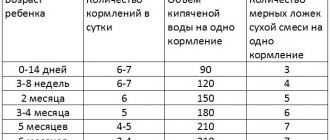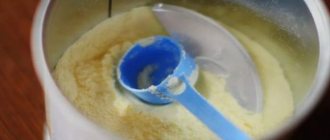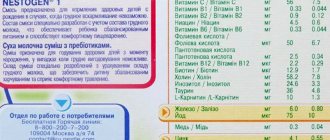Home / Child / Child nutrition / How to change formula: rules for safe transition from one product to another
143391
1
- When should you change the mixture?
- How often can this be done
- Transition rules and scheme for introducing a new mixture
- What not to do
- What difficulties may arise
- How to understand that a new mixture is suitable
- Useful video on how to switch to a new mixture
The apparent simplicity of artificial feeding turns into various difficulties, for example, a particular product may not be suitable for the child. And then the question arises - how to change the mixture?
Choosing high-quality and safe food for a baby is a responsible task. If for some reason the formula is not suitable, choosing a new product becomes stressful for the baby. Therefore, parents must take into account all the nuances to minimize the consequences.
When should you change the mixture?
You cannot simply transfer a newborn from one formula to another - at least there must be good reasons for this. If the baby feels well and eats with appetite, there is no reason to make adjustments to his diet.
The reasons why you have to change the usual mixture to a new one are the following factors:
- allergy to the “old” composition;
- the need to introduce therapeutic nutrition due to emerging health problems in the baby (for example, lactase deficiency);
- transition to adapted dairy products after medicinal formulas, due to the elimination of the disease in the child;
- the baby reaches the age of introducing a new product due to the increased needs of the child’s body;
- the baby’s categorical refusal to eat, insufficient weight gain; more about the norms of weight gain in infants →
The following signs of trouble in his body will indicate that a baby needs to switch to a new formula:
- Changes in behavior - drowsiness, disinhibition, increased excitability.
- The baby cannot maintain time intervals between meals without receiving a sufficient amount of formula.
- Excessive regurgitation after finishing feeding or several times during the day.
- Digestive problems - colic, flatulence, green stool.
- The appearance of allergies.
If your baby has these symptoms, he should be shown to a pediatrician. A specialist will help you find out the cause of the condition. If it was caused by inappropriate baby food, the doctor will give recommendations and advise.
Scheme of transition from one mixture to another
To introduce a new dairy product, you need to prepare 2 bottles: with the new and the old composition.
The step-by-step replacement looks like this:
- A baby up to 6 months old is asked to try 10 milliliters of unfamiliar food at the first feeding. The rest of the diet remains unchanged: the usual supplementary feeding in the morning and at other times.
- The next day, the norm of the new food is increased by the same amount, feeding it in the evening. Continuation is possible if the baby felt well during the day and had no problems with bowel movements.
- Over the next 7 days, complementary feeding is increased in the morning and evening by 20 milliliters.
- By the end of the week it will be 150 milliliters or 300 milliliters per day.
- The next stage is food replacement in the 2nd feeding (the entire portion).
- Thus, one feeding of a new mixture is added daily: 3rd, 4th, 5th.
The total duration of the transition is 13 days.
If it is necessary to urgently cancel an allergenic diet in feeding a baby, an accelerated option is used:
- First day, morning feeding – 10 milliliters.
- Second day, first and last feeding 10 milliliters.
- Third. The norm increases 5 times - up to 50 milliliters for two feedings.
- Fourth. Give 100 milliliters in the morning and evening. The daily dose is 200 milliliters.
- Fifth. The diet includes feeding 3 times a day with a new product of 150 milliliters. In total, the child receives 450 milliliters per day.
- Sixth day. The total volume is 600 milliliters, 200 in the morning, at lunch, and in the evening.
Replacing a dairy product with a “Next Step” for a child after six months is faster:
- On the first day, the daily portion is prepared in the following ratio: 75% or 3/4 is the usual food, 25% or ¼ is the introduced food.
- On the second day the proportion does not change.
- On the third day, the diet is divided 50x50: 2 parts old, 2 parts new.
- Fourth day. Feed as on the previous day.
- Fifth day: the share of the old product is ¼, the new product is ¾.
- Sixth day. Diet unchanged.
- The old mixture has been completely replaced.
The amount in milliliters depends on the volume of other types of complementary foods.
How often can this be done
Unfortunately, many parents are confident that until a suitable product is found, the baby’s diet can be changed almost indefinitely. This opinion is wrong. The child’s body will not be able to frequently adapt to the new mixtures that parents change; there is a load on the digestive tract and immune system, and as a result, health problems.
If the child digests new food well, does not spit up and looks healthy, then the product is suitable for him. You cannot change formula frequently for an infant at your own request, and if you have any doubts, you can contact your pediatrician and find out how he views this situation.
Transition rules and scheme for introducing a new mixture
There are recommendations explaining how to switch from one formula to another when artificial or mixed feeding. If you ignore them, there is no guarantee that the process will end successfully.
Let's look at how to properly change formula for newborns:
- Before switching to another formula, you should consult your pediatrician.
- You can change products within the same brand, for example, Nutrilon “1” to “deuce” or “Lactose-free” without following the phased introduction. That is, the “old” product is immediately replaced by another in full. You can’t do this with different brands. Adaptation of the baby's body to the new diet should be gradual.
- You can change the formula for an infant, provided that he is healthy - a high temperature or teething is not a condition when new food should be introduced into the baby's diet.
- You cannot switch to another baby food without good reason.
There are various schemes that allow you to switch to a new mixture without consequences. The pediatrician will tell you which one is better to choose. Read more about how to select and prepare the mixture →
Scheme No. 1
In different bottles, mom prepares two compositions - the usual and the new one.
You need to act according to the following plan:
- In the morning feeding, introduce 10 ml of an unusual mixture into the child’s diet. However, it cannot be mixed with the old product.
- If the baby’s health remains the same within 24 hours, he is offered 20 ml of the new formula at the first and fifth feedings.
- Every day, the mother should introduce 20 ml of an unusual product into the first and fifth feedings until they are replaced.
- After this, the new mixture gradually begins to replace the others according to the feeding schedule completely (not 20 ml, but a whole portion): 1st day - second, 2nd - third, 3rd - fourth, 4th - sixth, 5 -th - seventh.
On average, this scheme takes at least 2 weeks. If your child is allergic to baby formula, this option is not suitable for him. In this case, it is recommended to use the express method.
Scheme No. 2
Using this method, you can switch to a new diet in 6 days. Let's look at what the transition plan looks like in the table.
| Days of introduction | Volume of new mixture per dose (ml) | Feeding frequency | Total amount of new food per day |
| 1st | 10 | 1 | 10 |
| 2nd | 10 | 2 | 20 |
| 3rd | 50 | 2 | 100 |
| 4th | 100 | 2 | 200 |
| 5th | 150 | 3 | 450 |
| 6th | 200 | 3 | 600 |
It is impossible to change the formula for newborns without the supervision of a pediatrician - only a specialist, in case of failure, will be able to explain why the child has become intolerant to a particular product and how to proceed further. This is the only way to protect your baby from unpleasant surprises.
How to transfer a child to another formula correctly: different manufacturers
- When planning to transfer your baby from the first formula to the second from another manufacturer, be extremely careful and closely monitor his health.
This transition is carried out according to the following weekly scheme. On the first three days, 30 ml of the usual food is prepared and additionally, before the second meal, a new mixture is introduced (10 ml for the youngest and up to 30 ml for those who are slightly older). The rest of the time, the child is given the first mixture and his condition is monitored.
- On the fourth day, the second feeding is performed with a new mixture.
- During the last 3 days of the transition, the second mixture is used for one meal every day: third - fourth - first - fifth - sixth - seventh, that is, until a complete switch to the second mixture.
Switching to a new mixture is another scheme
What not to do
How to properly switch to another formula for a baby? You need to switch to a new diet gradually, over several days, but in no case abruptly. Changes in the child's condition should not be ignored. If your baby begins to spit up profusely or develops a rash, you should stop feeding him unusual foods and consult your pediatrician.
It is prohibited to introduce two or more new products at the same time. You cannot change the formula when the child has a cold or is about to be vaccinated - at this time his well-being is more important, since new food is additional stress for the baby.
What difficulties may arise
When switching to formula with breastfeeding or replacing it, including with mixed feeding, the child may refuse the new type of product.
Why does this happen and how should a mother act correctly in this situation? First of all, you should not forget about the recommendations for a gradual transition to a new diet. The fact is that the baby may not like the taste of the unusual mixture, and a sudden switch to it will result in such a reaction.
Secondly, the mother must be prepared for the fact that the process of adaptation will take some time. Even if the baby eats the first portions of new food with reluctance, you should not rush things and run to the store for the next brand.
In the case when the baby, when switching from one formula to another, continues to eat little by little and without appetite, there is no need to panic. Perhaps the volume he receives is sufficient for him. Attention should be paid to the number of urinations, weight gain and behavioral characteristics of the newborn. If they do not meet the norm, you need to look for ways to solve the problem of the child’s insufficient appetite.
How to change formula for a baby: rules for transition
Follow the simple rules for switching from one formula to another, then you will have at least some guarantee that the baby’s health will be under control. If these points are not followed, then such a change in diet may negatively affect his well-being, in particular, the newborn may develop constipation or diarrhea, colic, dysbacteriosis, and all this will be accompanied by sleep disturbances and loss of appetite. And in the aggregate, such rash actions can result in poor functioning of the gastrointestinal tract.
Don’t risk your baby’s health, try to follow these recommendations:
- Check with your doctor to see if you should switch to a different formula;
- When switching to another formula within one brand of baby food, you don’t have to follow strict gradations, just add a little new food to the previous one;
- If you are switching from an old formula to a new one, do it in stages, adding more and more of the new one each time, reducing the portion of the old one, helping the baby adapt to a completely different composition of the product;
- Last but not least, replace the nighttime meal, because it is not yet clear how the child’s body will accept this type of formula;
- Refrain from switching to a new diet if the baby has been vaccinated or is in a sick condition: fever, sleeps poorly, suffers from bowel problems or colic;
- It is not recommended to change the mixture without a good reason.
If you carefully follow these tips, your baby will easily switch to a new diet without negative consequences.
How to understand that a new mixture is suitable
Not all mothers know how to determine that a product is not suitable for their baby.
The following signs will indicate that an infant’s body has adapted to nutrition:
- Healthy skin. If there are no irritations or rashes on the newborn’s body, this indicates good tolerance of the administered mixture.
- Normal stool. The proper functioning of the intestines also indicates the quality of the selected diet.
- Intervals between feedings. If the baby eats every 3 hours and does not ask for a bottle more often, then the nutritional composition of the mixture fully satisfies his requirements.
- Weight gain by age.
- A restful sleep, interest in the surrounding space and the child’s good health at least indicate that it was painless to switch to an adapted formula after breastfeeding or replace it with a new product according to all the rules.
So, how to change baby formula correctly? The process should be as smooth as possible, only in this case everything will go smoothly and the baby’s health will not suffer. Frequently changing the formula for newborns, both for the sake of interest and for variety, is strictly prohibited, since you can switch from one food to another only for medical reasons, and not because of your own whim - your child is unlikely to need extra stress.











